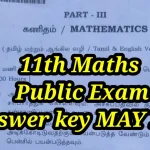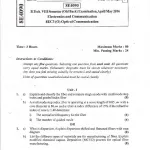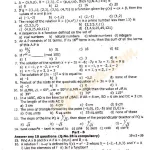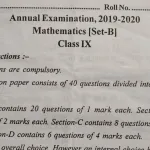1. How does Toto come to grandfather’s private zoo?
Grandfather bought Toto from a tonga-driver for five rupees, feeling that the monkey was out of place tied to a feeding-trough.
2. “Toto was a pretty monkey.” In what sense is Toto pretty?
Toto had bright eyes sparkling with mischief, pearly white teeth, quick and wicked fingers, and a gracious tail which served as a third hand.
3. Why does grandfather take Toto to Saharanpur and how?
Toto was too mischievous to be left at home, so grandfather took him to Saharanpur in a canvas bag.
4. Why does the ticket collector insist on calling Toto a dog?
The ticket collector classified Toto as a dog because there was no provision for a monkey in the rulebook, and he charged accordingly.
5. How does Toto take a bath? Where has he learnt to do this?
Toto would test the water’s temperature with his hand, step in, and use soap to bathe, mimicking the narrator’s bathing habits.
6. How does Toto almost boil himself alive?
Once, Toto jumped into a kettle of boiling water, enjoying the warmth, unaware of the danger, and had to be rescued.
7. Why was Toto’s presence kept a secret from Grandmother?
Grandmother disliked animals; to avoid her disapproval, grandfather kept Toto hidden until she was in a good mood.
8. Where was Toto kept after being brought home?
Initially, Toto was kept in a closet tied to a peg to prevent him from escaping and causing trouble.
9. What destruction did Toto cause in the closet?
Toto tore off the wallpaper, pulled out the peg, and shredded the narrator’s school blazer.
10. How did Toto behave in the stable with Nana, the family donkey?
Toto bit Nana’s ears, causing distress, and they never became friends.
11. What did Toto do with the dish of pulao?
Toto ate the pulao greedily, threw the plate at Grandmother when scolded, and escaped with the dish.
12. Why was Toto sold back to the tonga-driver?
Due to his mischievous behavior and the damage he caused, the family could not afford to keep him and sold him back for three rupees.
13. How did Toto react during the train journey to Saharanpur?
Toto poked his head out of the bag, grinned at the ticket collector, causing amusement and leading to a fare being charged.
14. Describe Toto’s tail and its usefulness.
Toto’s tail was like a third hand; he used it to hang from branches and to scoop up delicacies.
15. What does Toto’s behavior tell us about monkeys as pets?
Monkeys are intelligent and mischievous, making them unsuitable as household pets due to their unpredictable behavior.
16. How did Grandmother react upon discovering Toto?
Initially displeased, Grandmother eventually accepted Toto after realizing he was part of the family.
17. What lesson does the story convey about keeping wild animals as pets?
The story highlights that wild animals, despite their charm, can be destructive and are best left in their natural habitats.
18. How did Toto’s presence affect the other animals in the zoo?
Toto disturbed the other animals, preventing them from sleeping and causing general unrest.
19. What does the story reveal about Grandfather’s character?
Grandfather is portrayed as an animal lover, compassionate, and somewhat eccentric in his choices.
20. How does Ruskin Bond use humor in the story?
Bond uses Toto’s antics and the family’s reactions to create a light-hearted and humorous narrative.
21. Describe the initial setting where Toto was kept.
Toto was kept in a little store that opened into the narrator’s bedroom, tied securely to a peg.
22. How did Toto escape from the closet?
Toto pulled out the peg he was tied to, tore off the wallpaper, and escaped, causing destruction.
23. What was the family’s reaction to Toto’s mischief?
The family was amused initially but grew weary of his constant trouble-making and damage.
24. How did Toto’s behavior during meals cause problems?
Toto would steal food, create messes, and even throw dishes, disrupting family meals.
25. What does the story suggest about the compatibility of wild animals in domestic settings?
Wild animals like Toto may not adapt well to domestic life and can cause unforeseen issues.
Best Indian Books for The Adventures of Toto Question Answers – With Author & Publication Details
-
CBSE Class 9 English Moments Guide
Author: Rachna Sagar Editorial Team
Publication: Rachna Sagar
Content: Includes NCERT-based textual questions, value-based questions, vocabulary work, and grammar practice related to the chapter. -
Together with English Moments – Class 9
Author: Anamika Jaiswal
Publication: Rachna Sagar
Content: Provides long and short answer questions, HOTS, extra reference-to-context passages, and detailed summaries. -
Xam Idea English – Class 9
Author: VK Global Publications Editorial Team
Publication: VK Global Publications
Content: Covers multiple types of exam questions like MCQs, extract-based questions, and sample answer formats. -
Oswaal CBSE Chapterwise & Topicwise English Moments Book
Author: Oswaal Editorial Board
Publication: Oswaal Books
Content: Includes previously asked board questions, detailed solutions, and topic-focused question banks. -
Full Marks Guide for English Moments Class 9
Author: Full Marks Editorial Team
Publication: Full Marks Pvt. Ltd.
Content: Chapter-wise explanations, word meanings, long and short answer questions with model answers. -
Golden English Guide – Moments Class 9
Author: Nandini Sharma
Publication: New Age International Publishers
Content: Line-by-line explanation, grammar tasks, additional questions for deeper understanding, and summary. -
Evergreen Self-Study English – Moments Class 9
Author: M.L. Aggarwal
Publication: Evergreen Publications
Content: Sample papers, comprehension-based questions, textbook solutions, and additional exercises. -
MTG Foundation English – Class 9 Moments
Author: MTG Editorial Team
Publication: MTG Learning Media
Content: Focuses on concept clarity, extracts from the text, skill-based questions, and revision exercises. -
Educart English Language and Literature Class 9 Guide
Author: Educart Experts
Publication: Educart
Content: Objective questions, creative writing formats, solved previous year questions, and easy-to-understand content. -
All-in-One English CBSE Class 9
Author: Arihant Experts
Publication: Arihant Publications
Content: Concept notes, textbook exercises with solutions, extra questions for practice, and integrated grammar. -
Pearson English Companion – Class 9 Moments
Author: Meena Singh
Publication: Pearson Education
Content: Covers character sketches, important incidents, text explanation, and inferential questions. -
Cordova Learning Series – Class 9 English Moments
Author: Dr. Reena Jain
Publication: Cordova Publications
Content: Real-life application-based questions, value-based discussions, and sample question papers. -
Practice Guru NCERT Solutions Class 9 English
Author: Practice Guru Team
Publication: Practice Guru
Content: Concise textbook solutions, theme-based questions, and analytical writing practice. -
Brain Mapping Academy English Guide – Class 9
Author: V. Murali
Publication: Brain Mapping Academy
Content: Focuses on critical thinking, value-based MCQs, and chapter analysis with summaries. -
Sapphire English Literature Guide – Moments Class 9
Author: A. Banerjee
Publication: Sapphire Publishers
Content: Visual summaries, contextual questions, and creative writing practice tied to each chapter. -
Bright Learnwell English Class 9 Moments Companion
Author: Learnwell Team
Publication: Bright Publications
Content: Thematic questions, paraphrased passages, and grammar points linked to the story. -
Target CBSE English Moments Support Book Class 9
Author: R. Mehta
Publication: Target Publications
Content: Chapter synopsis, model test papers, and comprehensive Q&A sets. -
Kalyani CBSE Support Book – English Moments
Author: Shalini Verma
Publication: Kalyani Publishers
Content: Teacher-recommended question sets, fill-in-the-blank exercises, and theme-based interpretations. -
MBD Super Refresher English – Class 9
Author: MBD Group
Publication: MBD Publications
Content: Mind maps, key concepts, long/short answer formats, and vocabulary revision. -
Arya English Moments Master Guide Class 9
Author: D. Kumar
Publication: Arya Publishing Company
Content: Topic-wise detailed questions, character-based answers, and critical appreciation questions.
The Adventures of Toto Question Answers: A Complete Guide for Class 9 English
If you’re a Class 9 student studying The Adventures of Toto from the NCERT English Moments textbook, you’re in the right place. This chapter, written by Ruskin Bond, introduces us to a mischievous monkey named Toto and the chaotic yet humorous experiences of his new family. While the story itself is entertaining, mastering the question and answers can be a challenge. This article will walk you through everything you need to know to confidently tackle any exam or classroom discussion.
Understanding the character of Toto is essential. In most question papers, you’ll often find character-based questions that ask you to describe Toto’s behavior or personality traits. To answer these effectively, focus on using adjectives like playful, naughty, intelligent, and unpredictable. Support your answers with specific incidents from the story, like Toto tearing up the narrator’s blazer or taking a hot water bath.
Another popular type of question is based on the theme of the story. You may be asked to explain whether keeping wild animals as pets is right or wrong. Here, it’s important to include both the family’s initial excitement and the eventual problems they faced. Highlight how Toto’s behavior caused financial losses and daily disturbances. These points make your answer balanced and thoughtful.
Long answer questions require more detailed explanations. For example, a common 6-mark question might be, “Why did Grandfather finally return Toto to the tonga-driver?” In such responses, focus on structure. Begin with a short introduction, discuss Toto’s actions that led to the decision, and end with a strong concluding sentence. Using this format shows clarity and depth in your writing.
For short answer questions, try to keep your response within 30 to 40 words. Stick to the main point and avoid repeating parts of the question. A sample short answer could be: “Toto was sold back to the tonga-driver because he caused too much damage to the household and was too costly to keep.”
Expert educators suggest students practice reference-to-context questions as well. These are questions that give a passage from the chapter and ask for explanation or interpretation. Always identify the speaker, the situation in the story, and its relevance to the overall theme.
Vocabulary-based questions may also appear. Be prepared to explain the meaning of words like mischief, grinning, or scooping. Practice using them in sentences to improve your language skills and understanding of context.
If you’re preparing for internal assessments or unit tests, revise from NCERT-based question banks. Focus on sample answers and practice writing them in your own words. This not only boosts your writing speed but also helps you retain the material better.
To make your study more engaging, try group discussions. Sharing your views with classmates often brings up new interpretations of the story, which can be useful in subjective questions.
Remember, the key to excelling in The Adventures of Toto question answers lies in understanding the story deeply and practicing a variety of question formats. Use past papers, school guides, and self-tests regularly. Always aim to go beyond rote learning and connect with the story’s emotions and message.
FAQ for The Adventures of Toto Question Answers
What is the central theme of The Adventures of Toto?
The central theme revolves around the misadventures of keeping a wild animal as a pet, and how such decisions, though made with affection, often result in chaos.
Who is the author of The Adventures of Toto and what is his writing style?
Ruskin Bond is the author. His writing style is simple, humorous, and rich in storytelling, which makes the chapter enjoyable and easy to understand.
What kind of questions are usually asked from this chapter in exams?
Questions typically include character sketches, value-based questions, extract-based comprehension, and short summaries of incidents from the story.
Why is Toto described as ‘pretty’?
Toto is described as pretty because of his sparkling eyes, white teeth, expressive tail, and quick movements that give him a lively and charming appearance.
Why did Grandfather buy Toto?
Grandfather bought Toto from a tonga-driver out of sympathy and his fondness for animals, thinking the monkey would be a fun addition to his private zoo.
Why was Toto eventually returned?
Toto was too mischievous and destructive. He caused damage to household items, troubled other animals, and became expensive to maintain.
How should I prepare for long answer questions from this chapter?
Focus on writing structured answers with an introduction, body, and conclusion. Use examples from the story to support your points and keep your language clear.
Are there any moral lessons in the chapter?
Yes, the chapter subtly teaches that wild animals are best left in their natural habitat and that not all pets are suitable for home life.
How can I remember important points for my exam?
Make short notes for each scene, create a character map for Toto and Grandfather, and revise key incidents like Toto’s train journey or his bath time.
What are some important extract-based questions that could be asked?
You may be asked to explain lines describing Toto’s behavior, his interaction with Grandmother, or the episode involving the ticket collector.
How did Toto behave during his stay in the family?
Toto was curious, playful, and often destructive. He tore clothes, broke dishes, and even scared guests with his unpredictable actions.
What makes this story humorous?
The exaggerated descriptions of Toto’s antics, the reactions of family members, and the absurd situations (like being charged a ticket for a monkey) add humor throughout the story.
Is this chapter based on a real incident?
The story is inspired by real-life experiences, as Ruskin Bond often writes semi-autobiographical pieces, though certain events may be fictionalized for entertainment.
How does this chapter help in language learning?
It enhances vocabulary, comprehension skills, and helps students learn narrative techniques, all while keeping them engaged with an amusing plot.
Can this story be used for moral discussion in class?
Absolutely. Teachers often use it to spark discussions about animal rights, responsible pet ownership, and the line between affection and practicality.
Latest Posts
- Step-by-step guide to download and apply for jee mains admit card 202
- Comprehensive 2025 government holidays and recruitment details for job seekers
- JEE Mains Admit Card 2025: Your Step-by-Step Guide to Downloading the Hall Ticket
- Everything You Need to Know About 2025 Government Holidays Recruitment
- Comprehensive Guide to rrb d group recruitment 2025 – Eligibility, Vacancies, and Application
- Detailed guide to nps trust recruitment 2025 vacancies, eligibility and apply process
- Comprehensive guide to hpcl recruitment 2025 notification, vacancies, and application process
- ignou bed admission 2025 complete recruitment guide with eligibility and process
- Comprehensive Guide to Indian Army Agniveer Recruitment 2025 Notification and Jobs
- Everything You Must Know About CBSE Board Exams 2025 Changes & New Rules






